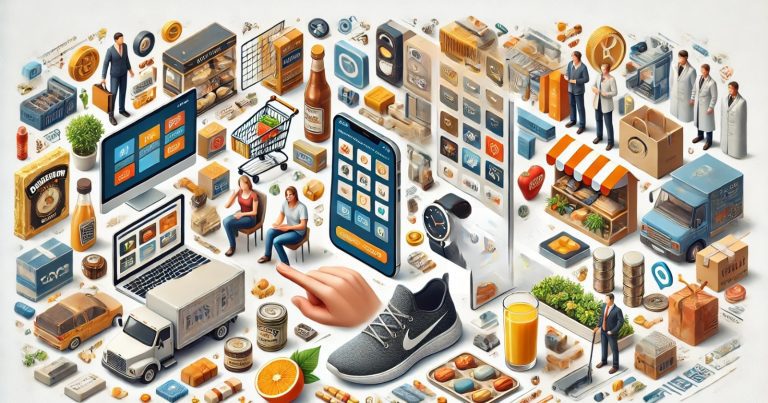Products are tangible goods that businesses produce or manufacture to sell it to individuals. The Types of Product describe various goods that firms produce and offer for sale in the marketplace. Products may be tangible physical commodities or intangible services that fulfil customer demands. In marketing, products are grouped according to usage, market, and consumer desire. The two broad types are consumer products and industrial products. Knowledge of the types of products enables companies to create good marketing strategies and serve customers effectively.
What is Product?
A product is made, produced, or available for sale to meet a customer’s need or desire. It may be a tangible product such as electronics, food, and apparel or an intangible product such as software, insurance, and e-learning. A product can be categorised based on usage, demand, and market segmentation.
Types of Product
The types of product are the various products businesses produce and sell to other companies or consumers. Consumer products are made for people, while industrial products are used to aid business operations and production. Each product has a specific function and market. Businesses carry out market research and examine current products before creating new ones.
Consumer Products
Consumer products are goods that consumers buy for home or personal use. They satisfy daily requirements, luxury desires, and lifestyle enrichment. They are also divided into four subgroups:
Convenience Products
Convenience products are regularly needed items that consumers buy often with minimal consideration. These products tend to be cheap and widely available in many stores. Since they involve little decision-making, consumers purchase them by habit or brand even when not comparing alternatives.
The products are built to be ubiquitous and heavily marketed while also being mìnhited in terms of actual users. Deals such as buy-one-get-one-free offers or discounts drive repeat purchases. Price competition is high, so strong branding and accessibility allow businesses to retain customers. Examples include bread and milk for groceries, toothpaste and shampoo for toiletries, and pens and notebooks for stationery.
Shopping Products
Shopping products are where customers compare products before a purchase. These are among the costliest human purchases and the most well-researched before a buyer decides. They compare quality, price, durability, and brand reputation, visiting several stores and reading reviews before they buy.
Retailers selling shopping products use branding, customer experience, and promotions to sway buying decisions. Enhancement of product attraction in the form of attractive packaging, after-sales support, instalment payment options, etc. Such goods include our clothing, furniture, and electronic gadgets like our smartphones, which we consumers choose based on our wants and needs.
Specialty Products
Speciality products are exclusive, high-value items where customers exhibit strong brand preference. They are rare in availability and provide their services at premium prices, which is desirable to a certain audience. That’s why demand for these products is so high, and buyers are willing to pay for them; they’ll wait or even travel to specific stores .
Speciality product businesses rely on brand reputation, exclusivity, and personalised marketing. This desirability is compounded with prestige advertising, influencer endorsements and premium customer experience. Exclusive showrooms, limited-edition launches, and premium services hold the product to its elite standard. These include luxury cars like Mercedes-Benz, branded watches like Rolex and designer cosmetics.
Unsought Products
An unsought product is not known to the consumer, and the consumer only purchases it when needed. Such things are things that people don’t think about until they come up with a particular scenario, like life insurance, funeral services, or emergency medical equipment. Because demand is unnatural, businesses must market these products to get the word out.
Marketing approaches include educational content, direct selling, and trust-building to inform scope customers. Public awareness campaigns emphasise the significance of these products, and various methods, such as telemarketing and personal selling, are used to convert reluctant buyers. Because unsought products are typically related to emergencies or other unexpected events, sales may be intensified by promoting reliability and security.
Industrial Products
Industrial products are utilised by manufacturers, businesses, or industries for the production of other goods and services. They are products utilised as input for the production of other products. In contrast to consumer goods, they are not directly consumed. These are for business and non-personal purposes. Examples of industrial products include raw materials, machinery, tools, etc. They are necessary for the functioning of business and are divided into five major categories:
Raw Materials
Raw materials are raw, unprocessed materials employed in producing finished products. Industries process these materials by refining, processing, or assembling. Because they are the basis for production, raw materials are transported in bulk and are critical in industries like textiles, construction, and manufacturing.
Companies that procure raw materials emphasise B2B selling, long-term agreements, and industrial networking. Prices vary with demand, supply, and world market conditions. Companies attend trade fairs, exhibitions, and vendor alliances to get stable supply chains. Examples are cotton for textiles, iron ore for steel, and wood for furniture making.
Capital Goods
Capital goods are long-term assets that companies leverage to manufacture products and services. These are not things we directly consume as we do with consumer goods, but they are vital for production. Severe examples of fixed assets include machinery, infrastructure, and equipment in the construction, manufacturing, and transportation sectors.
Due to the high capital investment needed and the frequent upgrading of these goods, companies emphasise customisation, financing options, and industrial advertisements to entice customers. To help ease the purchasing decision, manufacturers offer after-sales support, warranties, and leasing options. Direct selling combined with targeted marketing assists businesses in reaching industrial buyers in the market for equipment that produces goods over an extended time period.
Component Parts and Materials
Parts and materials are all semi-finished goods that require further assembly before they become final goods. They are crucial in sectors such as electronics, cars and appliances. As quality affects the final output and the end product, businesses are particular about high standards and consistency.
In the B2C ecosystem, part manufacturers work on B2B partnerships, quality assurance, and supply chain optimisation. Close relationships with the manufacturers allow for a seamless production and delivery process. Businesses spend money on testing and innovation to adhere to specifications. For instance, microchips for smartphones, car engines, and batteries for electronic systems.
Supplies and Services
Supplies and services are required for day-to-day business functions but do not directly participate in production. These cover office supplies, maintenance services, and IT services. Repeated purchases ensure businesses operate smoothly, efficiently, and productively across groups.
Because supplies and services are low-cost but high-frequency purchases, firms prioritise bulk purchase discounts, long-term contracts and customer loyalty programs. Good suppliers want to keep business and offer competitive pricing and constant quality. Examples include copy paper, ink for office printers, cleaning services, security personnel, IT support teams, etc.
Product Life Cycle
Development of product life cycle strategies helps the businesses to maximise profits & extend the product’s market life. All products go through four main stages in their lifecycle:
- Introduction Stage: Marketing efforts are high as the product is introduced. Businesses spend heavily on promotional programs, advertising, and awareness campaigns to gain traction with early adopters. They are generally expensive to produce initially and are typically unprofitable at this stage.
- Growth Stage: Sales grow as the customers embrace the product. Brand awareness is enhanced, and companies can extend distribution channels to cover a larger market. Competitors will emerge, prompting product differentiation and price competition.
- Maturity Stage: Sales start to grow rapidly; competition enters. Retailers are often obsessed with keeping customers around with discounts, loyalty programs, and product upgrades. Depending on how saturated the market is, this could lead to price wars that cost-effective methods of maintaining that profit must placate.
- Decline Stage: Sales decline due to changing market trends or innovations. Companies might stop making the product, re-brand it, or find niche markets to prolong its lifecycle. Companies typically realign towards newer and higher-margin products or services to maintain their competitiveness.
Products vs. Services
A product is a physical object that customers can interact with, unlike a service that cannot be touched and is built upon experiences. Products are tangible, but services are based on human know-how and knowledge.
Products and services are created by businesses to be sold to a customer in exchange for some money. But they differ in important ways. Products are tangible goods you can touch and use, such as a phone, a book, or a car. Services, in contrast, are intangible products, i.e., enabling experiences like educational courses, personal care, or entertainment like Netflix. Unlike products and services (they are intangible and designed to provide value through experiences rather than goods).
Based on customer requirements, businesses offer various service types. Benefits of Convenience: Many, like a car wash, help simplify everyday chores. People seek specialised services, such as massages or individualised lessons, for expert assistance. Others, like towing or waste management, fall under the category of unsought services, which are services that people need only under certain circumstances. Understanding the different types of customers in the sales process encourages businesses to create better sales strategies that help them reach the right customers.
Types of Product FAQs
1. What are product types of marketing?
Product types of marketing are consumer products (shopping, speciality, convenience, and unsought) and industrial products (components, capital goods, raw materials, and supplies).
2. What are different product types?
Different types are industrial products used by businesses and consumer products for individual consumption.
3. How does the product life cycle affect marketing strategies?
The product life cycle influences marketing, pricing, and promotion at all stages. Firms alter strategies based on sales trends.
4. What is the difference between product and service?
A product is a tangible item, while a service is an intangible experience provided by firms.
5. What are the types of production in business?
The types of production are mass production, batch production, and customised production, based on business needs.


